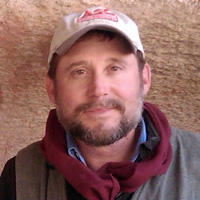My baby daughter has been drawing on my doorstep with purple chalk. Right now, it's just dots, but, having watched my four-year-old, I know it won't be long before more shapes find their way from her hand to our drawing surfaces. Watching her practice, I wondered about how our species learned to create art and, particularly, where.
By any standard, the Lascaux cave paintings are masterpieces of art, blending well-rendered images with the curves of the cave walls. Even the most naturally talented artist doesn't just pick up a piece of charcoal and knock these out. They were well-practiced at making these gorgeous works. Surely, there must have been great panels of temporary rock art containing the half-finished outlines of these artists, drawings in the sandy floors of caves, sketches on pieces of bark and hide, all of which have been lost to decay and weathering. Our ancestors must have been surrounded by art.
Next time you are at the DeYoung, take a minute to check out the eccentric flints at the Mayan exhibit. These are stone ceremonial blades that have been chipped to have faces, scorpion tails, curls. I once spent an hour drawing one, and I could only marvel at how this flint contained all the stone tool knapping techniques that I had ever seen, in one piece. A few decades ago, nine of these eccentric flints, possibly representing the Nine Mayan Lords of the Night, were recovered from Copan, and at the time they were heralded as possibly the finest example of stone tool making, by any culture, at any time, anywhere in the world.
Like Lascaux, somewhere there were workshops where the artists honed this incredible craft. As an archaeologist, and an artist myself, as amazing as the finished works of art of our ancestors are, it will always be the places of learning, of experimentation, that interest me. Somewhere, buried in the rain forests of Central America, there must be the discarded faces of a thousand Mayan gods, broken in practice, still sleeping.
With a Perspective, this is Mike Newland.
